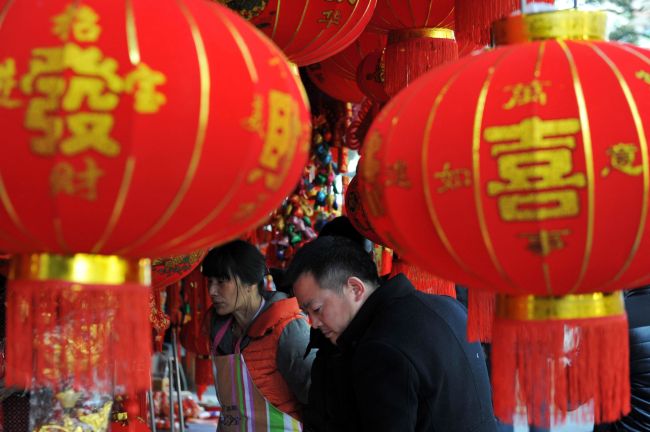[Weekender] Cross-cultural celebration of Lunar New Year
By Korea HeraldPublished : Feb. 13, 2015 - 19:29
The Lunar New Year is the largest annual holiday across Confucian societies in the world.
From China to Taiwan, Hong Kong to Singapore, billions of people, across nationalities and languages, are united in celebration of “Chunjie” which lasts over a week on the lunar calendar.
Here in Korea, the festival is called Seollal, shorter with just three days off and celebrated in a similar but different way. As more foreign nationals reside in Korea, with nearly 700,000 Chinese, the upcoming Lunar New Year holiday is becoming a focal point of inter-cultural understanding between countries.
From China to Taiwan, Hong Kong to Singapore, billions of people, across nationalities and languages, are united in celebration of “Chunjie” which lasts over a week on the lunar calendar.
Here in Korea, the festival is called Seollal, shorter with just three days off and celebrated in a similar but different way. As more foreign nationals reside in Korea, with nearly 700,000 Chinese, the upcoming Lunar New Year holiday is becoming a focal point of inter-cultural understanding between countries.

“Chunjie is a traditional festival celebrated for millennia in China,” Shi Ruilin, the Chinese embassy’s cultural counsellor, told The Korea Herald. “The festival has agricultural roots in praying for the following year’s good harvest and expelling the evil.”
Whereas Koreans rejoice the festival more calmly with the family, the Chinese celebrate it in a much more festive and communal way, he explained.
Like in Korea, China sees a flood of people returning home from the city to the countryside during the holidays. Only the number of trips are far greater in China, exceeding 2.8 billion.
“People seek the warmth of the family to get away from the city’s frosty relationships,” he said.
The counsellor thinks that due to the rapid commercialization of society and the resultant changes in lifestyle, many Chinese traditions could not be passed on through generations. By contrast, Korea’s relatively homogenous ethnicity and small territory have helped preserve traditional customs better than China, he said.
“With multicultural marriages between Chinese and Koreans on the rise, the holiday seems to be evolving into a culturally hybrid form.”
The Chinese embassy, in collaboration with the China Cultural Center and Korea-China Association for Cultural Exchange, hosted an event last Wednesday, “Lunar New Year China-Korea Connection Cultural Festival.” A troupe of musicians, dancers and martial artists from the Shandong Province in China presented dazzling performances in front of crowds at the center.
The Singaporean tourism ministry said that local residents and tourists “soak in a festive mood throughout the island, with celebrations in the form of colorful processions, seasonal markets, fireworks, lanterns and lion dances.”
The Chinatown Street Light-up, the Chingay Parade and the River Hongbao festivals in Singapore gather sizable international crowds through an extravaganza of performances and spectacles.
“Symbolically, new clothes are worn to welcome the New Year and every family thoroughly cleans their homes to ‘sweep away’ the ill-fortunes and evils,” the ministry told The Korea Herald.
When relatives and friends are invited to a host family, they bring two mandarin oranges, which are reciprocated by another set of two oranges — a gesture of exchanging prosperity.
Another common feature of the celebration in China and Korea is the small-sized “money pocket” called “Hong-bao” in China and “Luck pouch” in Korea; children fill them with cash they received from adults after bowing in respect.
Regional variations taken into account, an embassy official said that Chinese people have performed ancestral worship by offering foods, fruits and flowers on the table, a practice shared by Koreans.
By Joel Lee (joel@heraldcorp.com)
-
Articles by Korea Herald







![[Graphic News] More Koreans say they plan long-distance trips this year](http://res.heraldm.com/phpwas/restmb_idxmake.php?idx=644&simg=/content/image/2024/04/17/20240417050828_0.gif&u=)
![[KH Explains] Hyundai's full hybrid edge to pay off amid slow transition to pure EVs](http://res.heraldm.com/phpwas/restmb_idxmake.php?idx=644&simg=/content/image/2024/04/18/20240418050645_0.jpg&u=20240419100350)






![[From the Scene] Monks, Buddhists hail return of remains of Buddhas](http://res.heraldm.com/phpwas/restmb_idxmake.php?idx=652&simg=/content/image/2024/04/19/20240419050617_0.jpg&u=20240419175937)

![[KH Explains] Hyundai's full hybrid edge to pay off amid slow transition to pure EVs](http://res.heraldm.com/phpwas/restmb_idxmake.php?idx=652&simg=/content/image/2024/04/18/20240418050645_0.jpg&u=20240419100350)

![[Today’s K-pop] Illit drops debut single remix](http://res.heraldm.com/phpwas/restmb_idxmake.php?idx=642&simg=/content/image/2024/04/19/20240419050612_0.jpg&u=)